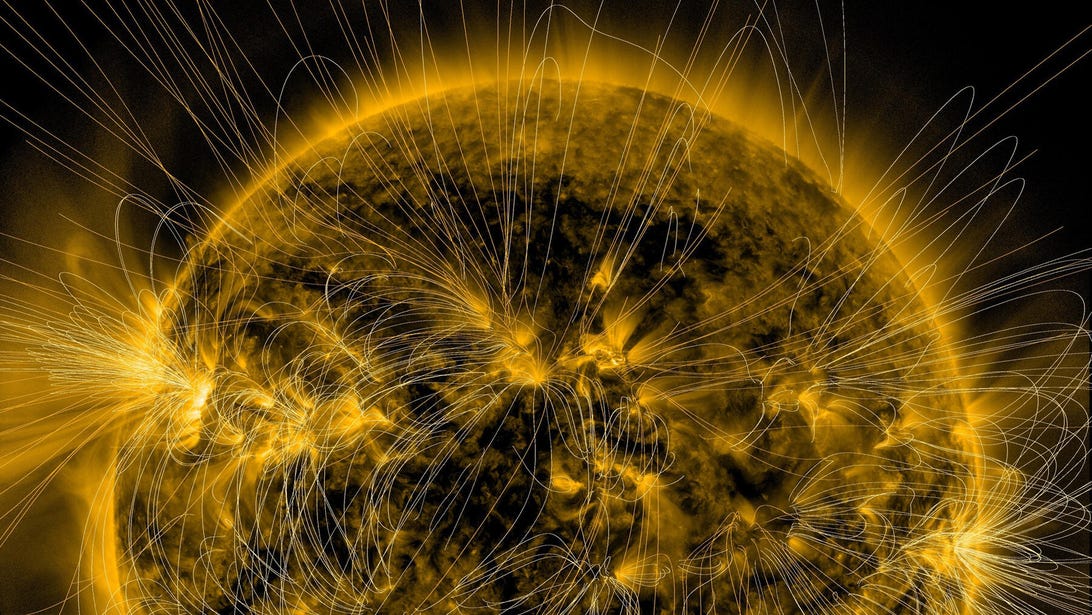
The sun's activity is expected to ramp up toward the next predicted maximum in 2025.
NASA GoddardThe blazing hot ball of gas at the center of our solar system could prove problematic for future moon explorers. Although it sits some 93 million miles from Earth, the activity that occurs on the sun's surface blasts radioactive particles out into the solar system. Earth's magnetic field protects us from the worst of this activity down here, but astronauts out on the moon are naked (...except for the spacesuits, I hope.)
A new study, published in the journal Solar Physics on Thursday, suggests NASA's upcoming Artemis missions to land humans on the moon might have a tricky experience with space weather. Analyzing 150 years of data, the researchers found some intriguing differences in the occurrence of extreme space weather events between even- and odd-numbered solar cycles.
"Until now, the most extreme space-weather events were thought to be random in their timing and thus little could be done to plan around them," said Mathew Owens, an astrophysicist at the University of Reading.
Solar cycles occur in 11-year blocks and see the inferno's magnetic fields flip north and south. We've only recently entered the odd-numbered Solar Cycle 25, which began sometime in December 2019 and will continue until about 2030. Activity on the sun will ramp up to the solar maximum, set to occur around 2025.
During the solar maximum, the sun gets wild as the magnetic field readies for its big flip. It experiences huge "coronal mass ejections" -- mammoth releases of plasma that billow out into the cosmos. These emanate away from the sun and, if they're pointed directly at the Earth, can affect things like communications satellites and even power grids. And that's with the protection of a magnetic field.
We don't have to imagine what might happen without one -- we've got plenty of evidence. In 2003, a gigantic solar flare was responsible for damaging the Hayabusa spacecraft, a Japanese Space Agency robot that became the first to return asteroid samples to Earth. And on the surface of the moon, protection from extreme space weather is limited.
Both NASA and the National Oceanic and Atmospheric Administration don't believe Solar Cycle 25 will be "particularly active" but extreme events will occur and we don't have a good way to predict them.
That's where the new research comes in. Looking back on 150 years of solar cycle data, researchers found that in even-numbered cycles, extreme space weather events were likely to occur early on. In odd-numbered cycles, like the one we're now in, those extreme events commonly occurred much later.
"These new findings should allow us to make better space weather forecasts for the solar cycle that is just beginning and will run for the decade or so," Owens said.
It's not clear why this happens, just yet, but it could have something to do with the way the sun and the Earth's magnetic fields line up during an odd solar cycle. Nevertheless, the new knowledge will be helpful in planning. Just like you might plan your trip to the supermarket on Wednesday, when the skies are clear, rather than Thursday, when the heavens are expected to open up, future missions to the moon (or even Mars) could take the new analysis into consideration.
The data suggests NASA's Artemis, which aims to have humans back on the moon by 2024, will really need to keep to its ambitious schedule to avoid the extreme space weather expected to occur at the end of this decade. Whatever the launch date, rest assured NASA has one eye on the forecast.
"There is no bad weather, just bad preparation," said Jake Bleacher, chief scientist for NASA's human exploration and operations mission directorate in September 2020 when discussing the new solar cycle.
"Space weather is what it is -- our job is to prepare."
from CNET https://ift.tt/3wjUATZ
via IFTTT



No comments:
Post a Comment